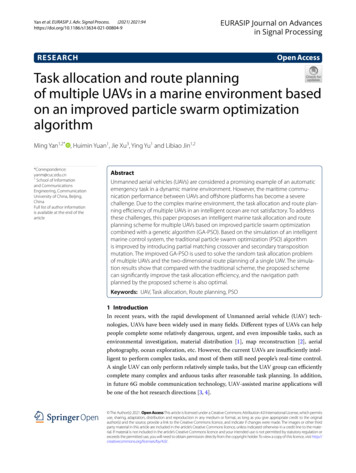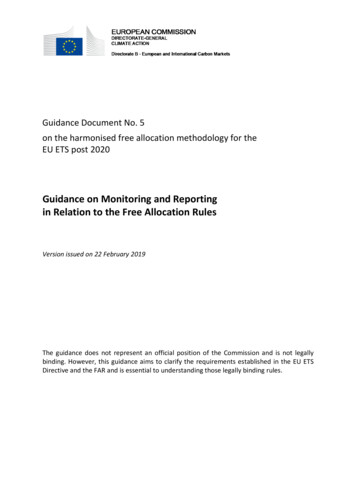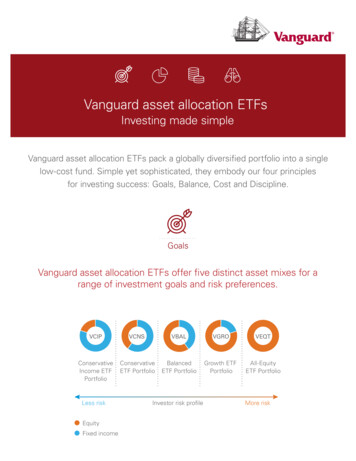
Transcription
(2021) 2021:94Yan et al. EURASIP J. Adv. Signal EURASIP Journal on Advancesin Signal ProcessingOpen AccessRESEARCHTask allocation and route planningof multiple UAVs in a marine environment basedon an improved particle swarm optimizationalgorithmMing Yan1,2* , Huimin Yuan1, Jie Xu3, Ying Yu1 and Libiao Jin1,2*Correspondence:yanm@cuc.edu.cn1School of Informationand CommunicationsEngineering, CommunicationUniversity of China, Beijing,ChinaFull list of author informationis available at the end of thearticleAbstractUnmanned aerial vehicles (UAVs) are considered a promising example of an automaticemergency task in a dynamic marine environment. However, the maritime communication performance between UAVs and offshore platforms has become a severechallenge. Due to the complex marine environment, the task allocation and route planning efficiency of multiple UAVs in an intelligent ocean are not satisfactory. To addressthese challenges, this paper proposes an intelligent marine task allocation and routeplanning scheme for multiple UAVs based on improved particle swarm optimizationcombined with a genetic algorithm (GA-PSO). Based on the simulation of an intelligentmarine control system, the traditional particle swarm optimization (PSO) algorithmis improved by introducing partial matching crossover and secondary transpositionmutation. The improved GA-PSO is used to solve the random task allocation problemof multiple UAVs and the two-dimensional route planning of a single UAV. The simulation results show that compared with the traditional scheme, the proposed schemecan significantly improve the task allocation efficiency, and the navigation pathplanned by the proposed scheme is also optimal.Keywords: UAV, Task allocation, Route planning, PSO1 IntroductionIn recent years, with the rapid development of Unmanned aerial vehicle (UAV) technologies, UAVs have been widely used in many fields. Different types of UAVs can helppeople complete some relatively dangerous, urgent, and even impossible tasks, such asenvironmental investigation, material distribution [1], map reconstruction [2], aerialphotography, ocean exploration, etc. However, the current UAVs are insufficiently intelligent to perform complex tasks, and most of them still need people’s real-time control.A single UAV can only perform relatively simple tasks, but the UAV group can efficientlycomplete many complex and arduous tasks after reasonable task planning. In addition,in future 6G mobile communication technology, UAV-assisted marine applications willbe one of the hot research directions [3, 4]. The Author(s) 2021. Open Access This article is licensed under a Creative Commons Attribution 4.0 International License, which permitsuse, sharing, adaptation, distribution and reproduction in any medium or format, as long as you give appropriate credit to the originalauthor(s) and the source, provide a link to the Creative Commons licence, and indicate if changes were made. The images or other thirdparty material in this article are included in the article’s Creative Commons licence, unless indicated otherwise in a credit line to the material. If material is not included in the article’s Creative Commons licence and your intended use is not permitted by statutory regulation orexceeds the permitted use, you will need to obtain permission directly from the copyright holder. To view a copy of this licence, visit http://creativecommons.org/licenses/by/4.0/.
Yan et al. EURASIP J. Adv. Signal Process.(2021) 2021:94The task planning problem of multiple UAVs can be divided into two parts, the taskallocation problem and route planning problem, which are interrelated and differentfrom each other. The task allocation problem is equivalent to the combinatorial optimization decision problem for multiple UAVs. It is a combination scheme designed tomeet UAV performance and the constraints. The purpose is to make a UAV consume theleast resources or obtain the maximum benefits with the shortest total path. The routeplanning problem involves planning a flight route from the starting point to the endpoint in the constrained task space and making the fitness function optimal. In order tosolve the task planning problem, many scholars have conducted a considerable amountof research. The common task allocation methods include optimization algorithms (e.g.,the Hungarian algorithm [5], branch definition method, graph theory, etc.), heuristicalgorithms (e.g., clustering algorithms, ant colony algorithms (ACOs) [6], particle swarmoptimization algorithms (PSOs) [7], genetic algorithms (GAs) [8], artificial bee colonies, etc.) and distributed algorithms (e.g., the decentralized Markov decision process,the contract net auction algorithm [9], etc.). Common route planning methods includetraditional algorithms (e.g., the Voronoi diagram method, the artificial potential fieldmethod [10], etc.), heuristic algorithms (the Dijkstra algorithm, the Floyd algorithm, theA* algorithm [11], etc.), and intelligent bionic algorithms.Currently, the inland application of UAV task planning is relatively mature. However,in the face of a complex and broad marine environment, UAV task planning still facesmany challenges. First, due to the vastness of the marine environment, the complexityof the constraints, and the difficulty of modeling, an appropriate representation methodfor environmental modeling is needed. In this way, the environmental information oftask planning can be accurately and reasonably expressed. Second, many task planningalgorithms have limitations. Therefore, various algorithms should be effectively combined according to specific problems to improve the optimization effect. Furthermore,many research target models are too idealized to change according to the actual application. They are also not easy to adapt and lack universality. The main contributions of thispaper are as follows:(1) An intelligent marine control system composed of UAVs and offshore platforms, including a system model, task allocation model, and route planning model, isestablished.(2) Partial matching crossover and second transposition mutation, which improve theiterative speed and the performance of the optimal solution, are introduced to improvethe traditional PSO algorithm.(3) The task allocation and route planning problems of multiple UAVs with randomtargets and constraints have been solved. A large number of simulation experimentsshow the task allocation efficiency of marine UAVs and anti-interference ability.2 Related workTo establish a suitable intelligent marine system model, many scholars at home andabroad have established a variety of marine systems in different scenarios. A probability graph fusion method of consensus theory and state predictors has been proposedto establish the communication model between UAVs [12]. In addition, a stochastic dynamic coastal environment model based on a Poisson distribution has beenPage 2 of 23
Yan et al. EURASIP J. Adv. Signal Process.(2021) 2021:94established to capture the environmental impact of coral reefs around the coastline[13]. However, the method of using UAVs to absorb solar energy as a communicationrelay node has higher requirements on the marine environment since the communication quality will be affected in the long-term due to a lack of sunshine and dark days.Under the assumption that the target probability map of the marine area is known, themarine system model is not suitable for the complex and changeable marine environment. The intelligent marine system proposed in this paper is set within the coverageof offshore base stations, and the motion model of UAVs satisfies a Gauss Markov process. The communication network is established between the offshore platform and thecloud platform through wireless transmission, and the communication link is randomlyassigned to a UAV.In UAV task planning research, the allocation of communication resources willdirectly affect the performance of the entire system, especially in future space-groundsea integrated networks [14–16]. Many scholars have improved the traditional algorithmaiming to improve the task allocation efficiency, optimize the planning route and expandthe application scenarios [17]. Among the topics, UAV mission planning is relativelymature regarding reconnaissance and striking, urban detection, disaster relief, forestfire monitoring, agricultural remote sensing, and other fields. To solve the multitargeturban tracking route planning problem of multiple UAVs, a novel algorithm combiningthe basic grey wolf optimizer (GWO) and Gaussian estimation of distribution (GED)strategy and adjusting the search direction by adjusting the weighted method has beenproposed [18]. Different algorithms for task allocation and enhancing the effectivenessof data perception have been proposed to minimize the incentive costs while ensuring the quality of sensing data [19]. IIn order to solve the new problems of the application of multiple UAVs in the rapid assessment of earthquake disaster areas, an efficientsimulated annealing hybrid particle swarm optimization algorithm, which generateshigh-quality solutions for rapid assessment task allocation problems, has been proposed[20]. In addition, an iterative greedy heuristic algorithm based on iterative solutiondestruction and reconstruction processes has been proposed to solve the logistics routing problem of truck UAV teams [21]. method based on the improved Voronoi diagramalgorithm to find the best path connecting all pressure areas and their injection pointshas been proposed to complete the agricultural investment task without revisiting [22].Moreover, due to the limited power endurance of UAVs, UAV systems in marineenvironments must consider network energy consumption [23, 24]. First, the networkenergy efficiency can be improved through the optimization of network resources [25,26]. Second, solar energy can be used to improve the coverage of UAVs in the marineenvironment. A method of absorbing and converting solar energy through a solar UAV,which can act as the communication relay node of a marine fleet, has been proposed toimprove marine communication coverage [27].However, research on UAV task planning in the complex, wide, and communicationlimited marine field is relatively limited. In order to establish a task management architecture in a restricted marine environment, a new algorithm combining an unsupervisedlearning strategy and an improved K-means algorithm has been proposed [28]. The algorithm first assigns different tasks to multiple UAV systems and then implements selforganizing mapping to address the execution problem based on each assigned task. InPage 3 of 23
Yan et al. EURASIP J. Adv. Signal Process.(2021) 2021:94order to solve the multitask allocation problem of a multiple unmanned surface vehiclesystem, an improved self-organizing mapping algorithm has been proposed [29]. Thealgorithm can allocate all tasks in the task area and obtain the set of task nodes thateach UAV needs to access. In order to study the underwater target search and tracking task, an improved particle swarm optimization algorithm has been proposed [30].The algorithm can perform the integrated tasks of unmanned aerial vehicles, unmannedground vehicles, and automatic underwater vehicles. In order to solve the route planning problem of multiple UAVs in marine target search, an improved route planningalgorithm based on the K-means algorithm and GA has been proposed [31]. In order tosearch for the best ship route, an algorithm combining the PSO algorithm and tangentgraph method has been proposed [32]. In order to search for safe and efficient routes inthe complex environment of wind farm water areas and ensure ship navigation safety, ahybrid route planning method based on the A* algorithm and reinforcement learningalgorithm has been proposed [33].All the above studies first selected a relatively specific application scenario of marineor water environments. Furthermore, the problem model is established under the condition of meeting the environmental constraints. Then, the model is improved on the basisof the traditional algorithm. Finally, the scheme is verified to improve the task planningefficiency. The goal of this paper is to establish an intelligent marine UAV task planningsystem. It is hoped that in the complex and changeable marine environment, accordingto the randomly generated task points, demand, threat area, and other characteristics,the system can quickly plan the task and design routes. Furthermore, regarding the system, the structure is relatively simple, the calculation costs are low, and the anti-interference ability is as strong as possible. Therefore, this paper makes many improvements inenvironment modeling, constraint setting, algorithm structure simplification, and modeluniversality.3 MethodsThe UAV task planning model is divided into three parts: the system model, task allocation model, and route planning model. The system model includes a UAV model, mobilemodel, and communication model. The symbols used in this paper are summarized inTable 1.3.1 System model3.1.1 UAV modelAs shown in Fig. 1, we establish an intelligent ocean control system composed of multiple offshore platforms and multiple UAVs. As the base station in the intelligent oceansystem, the offshore platform allocates network resources (bandwidth and channel) toUAV and assigns tasks (such as environmental monitoring, material distribution, etc.) toUAV. The communication between the platform and the UAV is established through thewireless link.Offshore platforms are represented by set O, roi represents the coverage radius of offshore platform Oi , and ρi represents the maximum density of UAVs within the coverageof offshore platform Oi . When ρimin ρi ρimax is satisfied, the number of UAVs thatcan be covered by offshore platforms Oi isPage 4 of 23
Yan et al. EURASIP J. Adv. Signal Process.(2021) 2021:94Page 5 of 23Table 1 Symbol and descriptions in this paperSymbolDescriptionUThe set of UAVsOThe set of offshore platformsCThe set of tasks. c0 is the warehouse centerHiThe set of wireless linksgpThe iterations of particlesρiThe density of UAVs within the coverage of offshore platforms oiQk (xi , yi )The coordinates of UAV ukϕk,iThe Signal noise ratio (SNR) of UAV under offshore platform oipkThe transmission power of UAV ukµk , iThe route loss index from UAV uk to offshore platform oiσThe additive white Gaussian noiseNu , NcThe number of UAVs and task pointsDThe total path of the UAVqiThe material demand of the task point citk , vkThe travel time and speed of UAV ukdi,jThe distance between task point ci and task point cjdkThe distance that UAV has traveledlkmax , lkminThe maximum range and minimum inertial distance of UAV uklki , LkSegment i and the total travel of UAV ukθkmaxThe maximum horizontal deflection angle of UAV ukFThe fitness function of route planningG0The threat zone collision factorNpThe number of particlesPThe set of particlesPbesti , GbestiThe local optimal solution and global optimal solution of particlea1 , a2 , c1 , c2 , ωThe acceleration constants, random function, and inertia variableof particles, respectivelyFig. 1 Schematic diagram of the intelligent ocean control system
Yan et al. EURASIP J. Adv. Signal Process.Ni (2021) 2021:94Page 6 of 2312πρi roi, i 1, 2, . . . , n2(1)Then, the total number of UAVs in the system can be expressed as Nu:Nu n(2)Nii 13.1.2 Mobile modelWe limit the motion of UAVs in the two-dimensional plane of an intelligent ocean system. A UAV can be regarded as a type of network communication node when it movesover the sea or communicates with a platform. We use coordinates Qk (xi , yi ) to represent the specific location of the UAV. The trajectory of the UAV is described as severaltrack points in the flight period of the UAV, and then the motion process of the UAVcan be modeled as a Gauss Markov process. The next movement of the UAV is relatedto the velocity and direction of the current movement. skt and rkt represent the speed anddirection of the UAV uk at time t, respectively. They can be calculated by the followingformulas:skt skt 1 (1 )s k 1 2 α t 1(3)rkt rkt 1 (1 )r k 1 2 β t 1(4)where α and β are random variables following a Gaussian distribution, and ( [0, 1])is the randomness in the Gaussian Markov process. When 0, the track points of theUAV are completely random.When 1, the UAV moves at a constant speed and direction. s k and r k represent the average velocity and direction of the UAV, respectively.3.1.3 Communication modelThe wireless links that can be generated by offshore platforms are limited, and the setHi is used to represent the covered wireless link sets of offshore platforms oi . The offshore platform allocates tasks to UAVs by establishing communication links. Due to themutual interference between UAVs covered by the same offshore platform, the signal-tonoise ratio of UAV uk can be calculated as: µk,iϕk,i pk dk,i µj,ik i pj dj,i σ2(5)where pk and pj are the transmission power of UAVs uk and uj , respectively. dk,i and µk,iare the distance and path loss index from UAV uk to offshore platform oi , respectively. σis additive Gaussian white noise.3.2 Task allocation modelTo understand more ocean information and conduct rescue and disaster relief, UAVs needto perform daily monitoring tasks and emergency tasks. Based on this, the task allocation
Yan et al. EURASIP J. Adv. Signal Process.(2021) 2021:94Page 7 of 23of UAVs in the coverage area of offshore communication base stations includes not onlythe number of tasks allocated to UAVs but also the execution sequence of each task, whichcan be summarized as a vehicle routing problem (VRP) [34–36]. This section only considers the task allocation order of UAVs in the mission area and does not consider the specificflight path of UAVs between each task point, so that the UAVs can meet the requirementsand constraints of the task point, and, at the same time, the total flight straight path is theshortest.The target function of the VRP problem can be expressed as:nmD min((dk xi 1 di 1,i ))i 1 k 1(6)Formula (6) shows that under the current path, the minimum length of the sum of theflight path of each UAV and the total path that will reach the next task point to the destination. When the value of the fitness function is small, the task allocation result is better.3.3 Route planning modelBefore UAV route planning, environment modeling is needed to convert all types of physical information into a digital model, which is convenient for computer processing. In thispaper, the UAVs in the offshore environment used to conduct routine marine investigation tasks and emergency tasks are the research examples. Considering the environmentalthreat area and the performance constraints of UAVs, an optimal flight route from the startto the end is planned.There are threats such as reefs, birds, marine currents, and wind shear in the offshoreenvironment, which can be represented by ellipses in a two-dimensional environment.Once a UAV enters these areas, it will crash, which means that the damage probability of aUAV in this area is 1. This is represented by the following set:(xi , yi ) (xi , yi ) (xi a)2 (yi b)2 r 2(7)Therefore, the threat zone can be expressed as (a, b, r), where (xi , yi ) are the coordinatesof the UAV, (a, b) are the coordinates of the center point of the threat area, and r is theradius of the threat area.The standard used to measure the merits and disadvantages of UAV tracks is a the fitnessfunction. Considering the environmental threat, constraints, and the length of the UAVrange, Formula (8) defines is the fitness function of UAV route planning:F n· n 1i 1 J1i J2i J3iLk · G0k 1 ϕk(8)where ϕk is the signal-to-noise ratio of the UAV on offshore platform ok , which can becalculated by Formula (5). J1i , J2i , and J3i are the return values of the three constraintconditions in the route of segment i, and a value of 1 means that the constraint conditionis satisfied; otherwise, the value is 0. G0 is the collision factor of the threat area. If a pointintersecting the threat area is detected in each route, it is determined that the route collides with the threat area, and G0 0.1. If not, then G0 0.
Yan et al. EURASIP J. Adv. Signal Process.(2021) 2021:94Page 8 of 23Formula (8) shows that when the constraint conditions are met, the communicationinterference of UAVs by the offshore platform is the minimum, and the route does notcollide with the threat area. The fitness function with the shortest range should be aslarge as possible.4 Improvement and implementation of PSO4.1 Traditional PSOThe first step of the traditional PSO algorithm is to initialize the particle swarm. Then,the fitness of the particles is calculated. The global optimal solution and local optimalsolution are updated according to the fitness. Finally, the velocity and position of thenext generation of particles are calculated by updating the velocity and position formulauntil the maximum number of iterations is reached. The updating formula of the velocityand position of particle i isvik ωvik 1 a1 r1 (Pbesti yik 1 ) a2 r2 (Gbesti yik 1 )yki yik 1 vik(9)(10)where vik is the component of the velocity vector of particle i in iteration k. yki is component of the position vector of particle i in iteration k. a1 and a1 are acceleration constants, which are responsible for adjusting the maximum speed of particle learning. r1and r2 are random functions with values ranging from 0 to 1. w is the inertia weight(nonnegative), reflecting the influence of the individual particle history at present.In Formula (10), the first part represents the previous velocity of the particle. Thesecond part is the “cognition” part, which represents the distance between the currentposition of particle i and its historical optimal position, which is equivalent to the localoptimal solution. The third part is the “society” part, which represents the distancebetween the current position of particle i and the optimal position of the population,which is equivalent to the global optimal solution. The final motion direction of particlesis affected by the above three parts, as shown in Fig. 2.Fig. 2 Schematic diagram of particle motion direction
Yan et al. EURASIP J. Adv. Signal Process.(2021) 2021:94Compared with the traditional algorithm, PSO has a memory function. The updateprocess is affected by the local optimal solution and the global optimal solution insteadof blind random selection, which greatly improves the search efficiency. Furthermore,fewer parameters need to be adjusted, and the structure is simple and easy to implement. However, because of these advantages, the PSO algorithm loses diversity of thesearch space. Furthermore, it easily produces premature convergence, has poor localsearchability, and easily falls into the local optimal solution.4.2 Improved PSO algorithmIn view of the above shortcomings, many domestic and foreign researchers have proposed some improvement methods. These improved methods can be divided into twocategories. One category improves the inertia weight, contraction factor, velocity, andposition update process of particles on their own. The other category combines the PSOalgorithm with another algorithm that can compensate for its shortcomings so as toimprove the performance of the algorithm. In this paper, an improved particle swarmoptimization combined with a genetic algorithm (GA-PSO) is proposed. By introducingcrossover and variation, the velocity and position updating formula of PSO are improvedto increase the diversity of the search space and avoid falling into the local optimalsolution.4.2.1 Local optimal solutionPartially matched crossover (PMX) refers to two invalid chromosomes or duplicate individual genes after randomly selecting two crossover points in individual chromosomesfor partial gene exchange. In order to repair the chromosomes, the matching relationship of each chromosome is established in the cross-region, and the matching relationship is applied to the duplicate genes outside the cross-region to eliminate the conflict.Because PMX can ensure that the genes in each chromosome only appear once, wechoose this crossover strategy to solve the traveling salesman problem (TSP) and VRP.As shown in Fig. 3, PMX crossover mainly consists of the following steps:Fig. 3 Schematic diagram of PMXPage 9 of 23
Yan et al. EURASIP J. Adv. Signal Process.(2021) 2021:94(1) Two intersections are randomly selected, and the sequences between the two intersections are the exchanged segments.(2) The new parent sequence is obtained by exchanging the positions of the exchangedsegments.(3) Conflict detection is performed on sequences. According to the exchange segmentof the two-parent sequences, the two-child sequences with mapping relationships can beobtained. The traversal repeat points in the offspring sequence outside the exchange segment are exchanged one by one according to the mapping relationship of the exchangedsegments until there is no conflict.(4) The final offspring sequence is obtained.In this paper, each particle represents a task planning path, so the parent sequence isthe particles before the crossover operation, and the points that compose the sequenceare the task points. Finally, the target function values of the new particle sequence andthe parent sequence are compared. If the target function after crossover is small, thecross-particle sequence is stored in the local optimal solution, and the correspondingtarget function value is updated.4.2.2 Global optimal solutionThe crossover process of the global optimal solution is the same as that of the local optimal solution. The final new particle sequence is compared with the target function valueof the parent sequence. If the target function value after crossover is smaller, the crossedparticle sequence is stored in the global optimal solution, and the corresponding targetfunction value is updated. The global optimal solution is updated according to the minimum value of the local optimal solution.4.2.3 The particle itselfAccording to Formula (9), each particle will generate a pair of random numbers in theprocess of an iteration. Transposition mutation is equivalent to exchanging the order oftask points in a path corresponding to two random numbers. This occurs as shown inFig. 4.Finally, the target function values of the new particle sequence and the parentsequence are compared. If the mutated target function value is smaller, the mutated particle sequence is stored in the local optimal solution, and the corresponding target function value is updated.4.3 Algorithm implementation for the task allocation problemUAVs need to meet some constraints in task allocation. In the intelligent marine systemstudied in this paper, the constraints can be divided into the task point constraints, thetask order constraints, and the constraints of the UAV itself. The details are as follows:Fig. 4 Diagram of secondary transposition variationPage 10 of 23
Yan et al. EURASIP J. Adv. Signal Process.(2021) 2021:94Page 11 of 23nmxki,j 1(11)nmxki,j 1(12)i 1 k 1j 1 k 1Formulas (11) and (12) indicate that each task point can only be accessed by one UAVonce. xki,j is the decision variable. When UAV uk arrives at task point ci from task pointci , the value is 1. Otherwise, the value is 0.nxk0,j nxkl,j j 0nxki,0(13)xki,l 0(14)i 0j 1ni 1Formula (13) indicates that the UAV starts from the warehouse and finally needs toreturn to the warehouse. Formula (14) represents the node balance constraint, and thetotal number of UAVs starting from the task point must be consistent with the totalnumber of UAVs arriving at the task point.nnxki,j qi qk(15)nnxki,j di,j kmax(16)i 0 j 1i 0 j 1Formulas (15) and (16) represent the material loading constraint and travel constraint ofeach UAV, respectively. The material requirement qi of task point i must be less than themaximum material loading q i of UAV uk . The flight distance from task point ci to taskpoint cj must be less than the maximum travel lk of UAV uk .tk xi 1,i tu(i 1),i tω(i 1),i(17)Formula (17) indicates that the time for the UAV to go to the task point must be withinthe task time window. The time window tωi,j is an interval, and only when the task iscompleted in this interval can it be regarded as an effective task.qk , lkmax , tωi,j 0(18)Formula (18) indicates that the material loading capacity qk , maximum range lk andtime window tωi,j from task point ci to task point cj of UAV uk are all positive numbers.Algorithm 1 describes the constraint process in the UAV task allocation problem.The input part sets the maximum material loading capacity, flight speed, and maximumrange of UAVs. The number, location, material demand, and time window of task pointsare set randomly. Then, initialization and memory preallocation are conducted. Then,
Yan et al. EURASIP J. Adv. Signal Process.(2021) 2021:94when proceeding to the next task point from the current position, it is necessary to judgewhether the constraint conditions are satisfied in turn according to the above formulas(11–18). If all of the constraint conditions are met, the implementation will continue. Ifthe constraints are not met, the UAV returns to the warehouse and a new UAV is arrangedto perform the task. After all task points are completed, all UAVs return to the warehouse.Algorithm 2 describes the UAV task allocation problem based on improved GA-PSO.First, the UAV, task point, warehouse, and particle are input and set initially, and thememory is preallocated. Then, the optimal solution of the target function of each generation of particles is compared. The PMX operation is performed on the local optimalsolution and the global optimal solution, and the secondary trans
A single UAV can only perform relatively simple tasks, but the UAV group can eciently complete many complex and arduous tasks after reasonable task planning. In addition, in future 6G mobile communication technology, UAV-assisted marine applications will be one of the hot research directions [3, 4]. Abstract


![[Title to come] DSP Dynamic Asset Allocation Fund](/img/24/dsp-dynamic-asset-allocation-fund.jpg)







